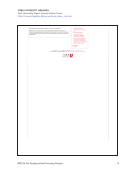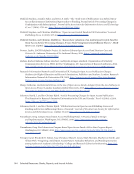24 Survey Results: Survey Questions and Responses
Hybrid or not listed in DOAJ
Illegitimate journals
Journal author agreement or licensing requirements did not meet our criteria.
Limit to one per fiscal year. First author from another university (though co-authorship is fine).
Not up to scholarly standard
One was a delayed-access model publication two did not meet fund policy requirements.
Our aim is to have authors self-screen for eligibility. In order to submit a funding application, authors
must check a box to attest to having no alternative funding, for example. Applications for hybrid journal
APCs end up with the majority of rejections, because the “pure” vs. hybrid distinction is not necessarily
obvious to authors. Having co-authors from other universities does not disqualify our authors from
receiving funds from our program (we divide the fee evenly by the number of authors and pay for the
university share).
Our fund was exhausted.
Out of money.
Predatory publisher, journal not listed in an OA directory, author submitted an article but it was not
submitted for publication.
Problem meeting fiscal year deadline for submitting paperwork.
Request was withdrawn article not accepted by journal co-author had already received funding from
OA fund in same fiscal year publisher failed to meet fund criteria
Suspected predatory journals
The author is no longer affiliated with the university.
The request was actually for page charges, not APC.
There were a variety of reasons. In some cases the faculty member submitted an application for a
hybrid journal, which was not allowed in this funding cycle. Faculty who had already been allocated
funds reapplied, and there were several submissions for non-OA journals.
We looked for these qualities in a journal: The author retained their own copyright the journal was
fully open access access was immediate, not delayed.
When an author uses their departmental card to pay for APC it disqualifies them from receiving
reimbursement from the COAP fund.
22. How many articles has the fund supported in total (since inception through FY16)? N=29
Minimum Maximum Mean Median N
13 957 106.90 75.00 29
Articles
13
13
20
23
27
30
Hybrid or not listed in DOAJ
Illegitimate journals
Journal author agreement or licensing requirements did not meet our criteria.
Limit to one per fiscal year. First author from another university (though co-authorship is fine).
Not up to scholarly standard
One was a delayed-access model publication two did not meet fund policy requirements.
Our aim is to have authors self-screen for eligibility. In order to submit a funding application, authors
must check a box to attest to having no alternative funding, for example. Applications for hybrid journal
APCs end up with the majority of rejections, because the “pure” vs. hybrid distinction is not necessarily
obvious to authors. Having co-authors from other universities does not disqualify our authors from
receiving funds from our program (we divide the fee evenly by the number of authors and pay for the
university share).
Our fund was exhausted.
Out of money.
Predatory publisher, journal not listed in an OA directory, author submitted an article but it was not
submitted for publication.
Problem meeting fiscal year deadline for submitting paperwork.
Request was withdrawn article not accepted by journal co-author had already received funding from
OA fund in same fiscal year publisher failed to meet fund criteria
Suspected predatory journals
The author is no longer affiliated with the university.
The request was actually for page charges, not APC.
There were a variety of reasons. In some cases the faculty member submitted an application for a
hybrid journal, which was not allowed in this funding cycle. Faculty who had already been allocated
funds reapplied, and there were several submissions for non-OA journals.
We looked for these qualities in a journal: The author retained their own copyright the journal was
fully open access access was immediate, not delayed.
When an author uses their departmental card to pay for APC it disqualifies them from receiving
reimbursement from the COAP fund.
22. How many articles has the fund supported in total (since inception through FY16)? N=29
Minimum Maximum Mean Median N
13 957 106.90 75.00 29
Articles
13
13
20
23
27
30
























































































































































